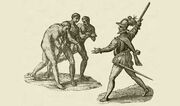
The Colonial period was a time of Spanish rule. The Spanish moved quickly to establish a network of political and economic oversight. Initially they were after the gold and the silver that was rich in Latin America. They used the indigenous people to dig out the gold and silver and took them back to Spain, which made them very wealthy while the poor indigenous people gained nothing from the trade. This is the first example of European countries using Latin America for their own benefit while leaving the natives with nothing. The effects of this can be seen even in the present day. As a result, even though Bolivia has the richest and the largest silver mine in the world, Potesi, it remains one of the poorest countries of the world.
After the acquisition of gold and silver became really uncommon, they continued to acquire their wealth through encomienda. Power and privilege was measured by owenership of property and land. The encomienda system was an awful system that treated its workers with brutality and put money in the hands of few, already rich conquistadors. The colonial world was divided between the Crown and the states bureaucracy. Here, you start to see the power pyramid. First you have the wealthy conquistadores who hold power and support the Crown, then you have the Church, and then the rest of the population that included the poor. The Crown assigned Peninsulares, who were people who were born in Europe and moved to the New World, to handle matters and hold power over the indigenous people. A lot of differeent systems began to come about with Spanish rule. Latifundia's was large piece of long owned by weatlhy powerful people and in them they had indigenous people as slaves. "Land was the major economic resource, the major determinant of social status, and the major source of political power in early America" (Meade 29). These huge masses of land were like their own little towns. The owners had everything they needed on their property to survive and entertain. They didn't have to venture outside their property for anything other than trade. Forming relationships with powerful people was of great convinience. The elite concentrated on power, prestige, and wealth. During this period, you could form realtionship's with the elite in various ways. For example, a wife's dowry was a criticla way of wealth and property transfer. Also, the comparadrazgo, or godparent. This was a way to be part of the elite by distant or not so distant relatives. Ways of obtaining power were creative and sometimes wrong.
Another consequence of the colonial rule was the beginning of the slave trade which was started by the Spanish conquerers. This was the first form of trade introduced to Latin America and opened these countries to the rest of the world. Since indigenous people refused to be slaves to the Europeans, they brought in slaves from African countries to work for them. This was the beginning of the cheap labour in Latin America and exploitation of labour. Since this was a cheap form of labour, the indigenous people were either pit out of their jobs or had to work under the same condition as the slaves. This heightened the economic gap and a very poor class of people emerged in Latin America which outnumbered the wealthy class by a great gap. The system of Latifundia and slavery are blamed for the problems that are still prevalent in Latin America, even at the present. These two factors are the root causes of problems such as extreme poverty, wide income gap, labour exploitation and human rights violations, lack of education and healthcare and drug cartels which are affecting the Latin American society today.
Colonialism is all about the excerise of power and its consequences it holds because of it.
After being tortured and mistreated on their own land, the indigenous people took a stand and started to revolt. They started leading rebellions and walks. One of the most famous rebellions was called the "The Great Andean Rebellion" and it was led by Tupac Amaru II who is still a figure in Latin America. Then the gender roles changed. Women were starting to fight and form revolts against the Spanish rule. The first main revolt happened in Haiti led by Toussaint L'Overture . Then followed Brazil and slowly more and more nations fought for their independence. In the end, they all got their independence after long hard battles. At the end of colonialism came neocolonialism which we learned they do not differ at all.
Even though many countries in Latin America have a long history of colonial turmoil, it didn't only bring negative things. Latin American countries are known for have a vast colorful culture. Part of this is becuase of colonialism, without it Latin America wouldnt be what it is today. Latin America represents diverse people and cultures of past times. Colonialism has brought a vast amount of goods and new technology over the years, dispite how cruel the people were often treaded. Colonialism has created a strong people who stand up for what they believe in and take action when it's needed. Revolutions and independance were based on the grounds of Colonialism, without upper society control and corruption there would be no need for such great leaders, that emerged out of the revolutions.